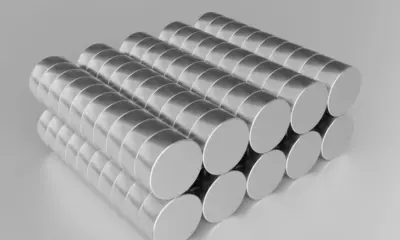Top Stories
NATO Declares ‘Turning the Tide’ on Russia’s Ammo Advantage

UPDATE: NATO Secretary-General Mark Rutte has just announced that the alliance is making significant strides in ammunition production, signaling a potential shift in the balance of power against Russia. Speaking at a defense industry forum in Bucharest, Romania, Rutte declared, “We are already turning the tide on ammunition,” highlighting a new confidence among NATO members after years of lagging behind Russian production.
For years, NATO warned that Russia produced significantly more ammunition than all NATO allies combined. Just five months ago, Rutte revealed that Russia was making four times the amount of ammunition, underscoring the urgency of the situation. However, he now states, “But not anymore,” suggesting that NATO is not only catching up but may soon close the gap entirely.
Rutte emphasized that NATO is currently producing more ammunition “than we have done in decades.” This surge in production comes as European nations, including Poland, Germany, and the UK, have heavily invested in local industries to boost shell production. Over a dozen new factories have been opened across Europe in the last two years, but challenges remain.
The focus is particularly on 155mm artillery shells, crucial for aiding Ukraine in its ongoing conflict with Russia. As the war drags on, the demand for these shells has skyrocketed, and NATO countries are scrambling to replenish their stockpiles. Rutte mentioned that dozens of new production lines are being opened, although he cautioned that many factories are still in the works.
Despite this positive outlook, experts warn that ramping up production is not an instantaneous process. Some estimates indicate that meeting the current demand may take until 2026 or later. The U.S. military, for instance, had aimed to produce 100,000 shells per month by October, but that goal has been postponed to mid-2026.
Furthermore, producing artillery ammunition involves complex supply chains and resources. Key components, such as propellant and explosives like TNT, are currently in short supply. The reliance on materials such as nitrocellulose has created bottlenecks, hindering the ability to meet production targets.
As NATO gears up to increase its ammunition supply, the urgency of the situation remains palpable. The alliance is not only focused on immediate needs but is also looking long-term to ensure it can compete effectively against Russia. The next steps will be crucial as NATO seeks to solidify its production capabilities and support Ukraine against ongoing aggression.
This developing story emphasizes the critical nature of NATO’s response to Russian military capabilities and the vital role of ammunition production in shaping the future landscape of European security. Stay tuned for further updates as NATO continues to address these urgent challenges.
-

 Top Stories2 weeks ago
Top Stories2 weeks agoMarc Buoniconti’s Legacy: 40 Years Later, Lives Transformed
-

 Sports3 weeks ago
Sports3 weeks agoSteve Kerr Supports Jonathan Kuminga After Ejection in Preseason Game
-

 Science3 weeks ago
Science3 weeks agoChicago’s Viral ‘Rat Hole’ Likely Created by Squirrel, Study Reveals
-

 Entertainment3 weeks ago
Entertainment3 weeks agoZoe Saldana Advocates for James Cameron’s Avatar Documentary
-

 Business3 weeks ago
Business3 weeks agoTyler Technologies Set to Reveal Q3 2025 Earnings on October 22
-

 Politics3 weeks ago
Politics3 weeks agoDallin H. Oaks Assumes Leadership of Latter-day Saints Church
-

 Lifestyle3 weeks ago
Lifestyle3 weeks agoKelsea Ballerini Launches ‘Burn the Baggage’ Candle with Ranger Station
-

 Health2 weeks ago
Health2 weeks agoInnovative Surgery Restores Confidence for Breast Cancer Patients
-

 Health2 weeks ago
Health2 weeks ago13-Year-Old Hospitalized After Swallowing 100 Magnets
-

 Lifestyle3 weeks ago
Lifestyle3 weeks agoDua Lipa Celebrates Passing GCSE Spanish During World Tour
-

 Health3 weeks ago
Health3 weeks agoCommunity Unites for Seventh Annual Mental Health Awareness Walk
-

 World3 weeks ago
World3 weeks agoD’Angelo, Iconic R&B Singer, Dies at 51 After Cancer Battle









